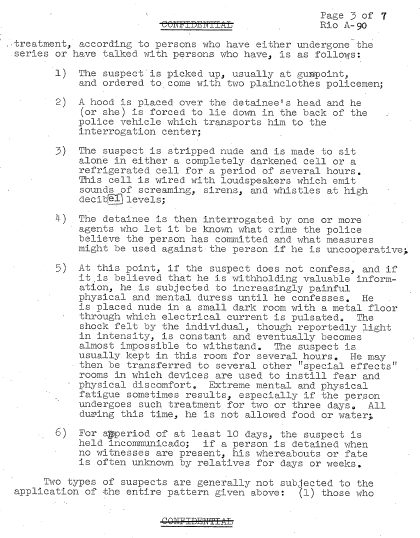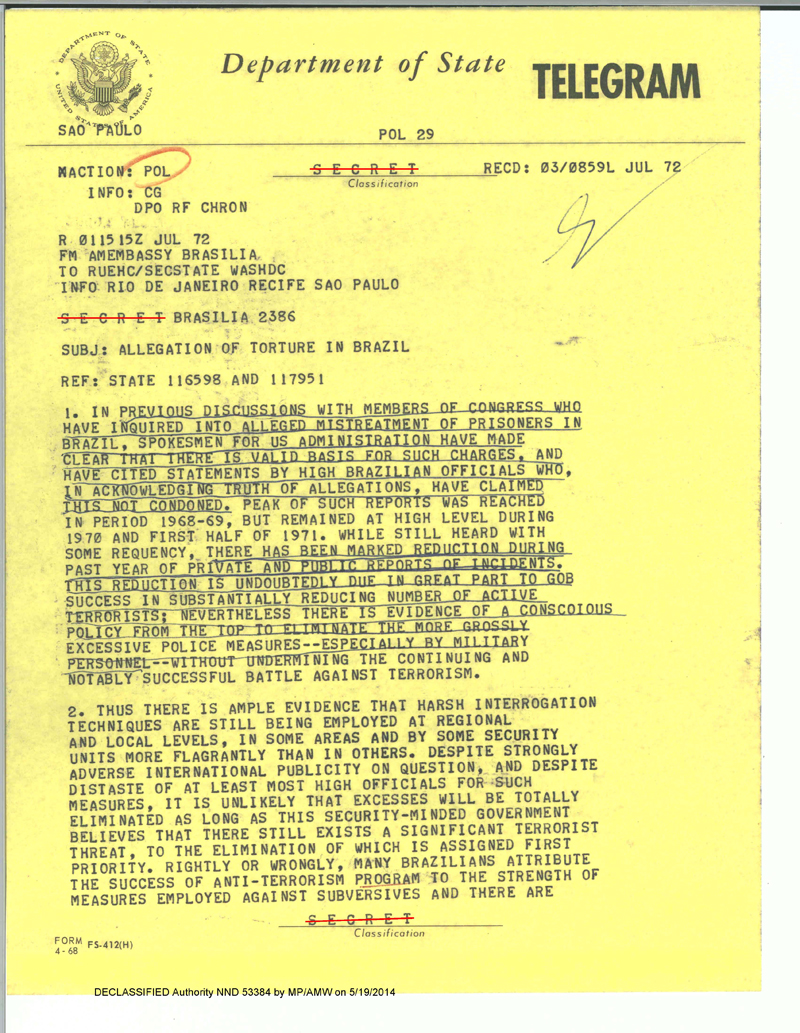Related LinksBrazil Marks 50th Anniversary of Military Coup Brazil Conspired with U.S. to Overthrow Allende Brazil Marks 40th Anniversary of Military Coup Nixon: "Brazil helped rig the Uruguayan elections," 1971
|
 From "one of the most detailed reports of torture ever declassified by the US government." Washington, DC, July 8, 2014 – The Brazilian military regime employed a "sophisticated and elaborate psychophysical duress system" to "intimidate and terrify" suspected leftist militants in the early 1970s, according to a State Department report dated in April 1973 and made public last week. Among the torture techniques used during the military era, the report detailed "special effects" rooms at Brazilian military detention centers in which suspects would be "placed nude" on a metal floor "through which electric current is pulsated." Some suspects were "eliminated" but the press was told they died in "shoot outs" while trying to escape police custody. "The shoot-out technique is being used increasingly," the cable sent by the U.S. Consul General in Rio de Janeiro noted, "in order to deal with the public relations aspect of eliminating subversives," and to "obviate 'death-by-torture' charges in the international press." Peter Kornbluh who directs the National Security Archive's Brazil Documentation Project called the document "one of the most detailed reports on torture techniques ever declassified by the U.S. government." Titled "Widespread Arrests and Psychophysical Interrogation of Suspected Subversives," the document was among 43 State Department cables and reports that Vice President Joseph Biden turned over on June 17 to President Dilma Rousseff during his trip to Brazil for the World Cup competition for use by the Brazilian Truth Commission. The Commission is in the final phase of a two-year investigation of human rights atrocities during the military dictatorship which lasted from 1964 to 1985. On July 2, the Commission posted all 43 documents on its website, accompanied by this statement: "The CNV greatly appreciates the initiative of the U.S. government to make these records available to Brazilian society and hopes that this collaboration will continue to progress." The records range in date from 1967 to 1977. They report on a wide range of human rights-related issues, among them: secret torture detention centers in Sao Paulo, the military's counter-subversion operations, attitudes of the Church on human rights violations, and the regime's hostile reaction in 1977 to the first State Department human rights report on abuses. Some of the documents had been previously declassified under routine release procedures; others, including the April 1973 report on psychophysical torture, were reviewed for declassification as recently as June 5, 2014, in preparation for Biden's trip. During his meeting with President Rousseff, Biden announced that the Obama administration would undertake a broader review of still highly classified U.S. records on Brazil, among them CIA and Defense Department documents, to assist the Commission in finalizing its report. "I hope that in taking steps to come to grips with our past we can find a way to focus on the immense promise of the future," he noted. Since the inception of the Truth Commission in May 2012, the National Security Archive has been assisting the Commissioners in obtaining U.S. records for their investigation, and pressing the Obama administration to fulfill its commitment to a new standard of global transparency and the right-to-know by conducting a special, Brazil declassification project on the military era. "Advancing truth, justice and openness is precisely the way these classified U.S. historical records should be used," according to Kornbluh. "Biden's declassified diplomacy will not only assist the Truth Commission in shedding light on the dark past of Brazil's military era, but also create a foundation for a better and more transparent future in U.S.-Brazilian relations." To call attention to the records and the Truth Commission's work, the Archive is highlighting five key documents from Biden's timely donation.
THE DOCUMENTSDocument l: Department of State, "Widespread Arrests and Psychophysical Interrogation of Suspected Subversives," Confidential, April 18, 1973 This intelligence cable, sent by the U.S. Consul General in Rio de Janeiro, provides detailed reporting on a "sophisticated and elaborate psychophysical" method of torture being employed by the Brazilian military against suspected militants. In response to growing international condemnation of human rights violations, the cable suggests, the Brazilian torturers have adopted more modern interrogation methods that leave less visible evidence of abuses. In cases where detainees are "eliminated," the military is also deceiving the press by claiming they were killed in a "shoot-out" while trying to escape. The cable was declassified on June 5, 2014, only eleven days before Biden's trip to Brazil in order for him to provide it to President Rousseff as a diplomatic gesture. But key sections of the document are redacted, presumably at the request of the CIA, that identify the military units responsible for these atrocities — information that would be of critical use to the Brazilian Truth Commission as it attempts to hold the military accountable for the atrocities of the past.
Document 2: Department of State, "Political Arrests and Torture in São Paulo," Confidential, May 8, 1973 The Consul General in Sao Paulo, Frederic Chapin, reports on a source described as "a professional informer and interrogator working for the military intelligence center in Osasco," an industrial suburb of Sao Paulo. The source has provided graphic details on methods of abuse, including a Brazilian form of "waterboarding" that involved putting prisoners in vats of water that forced them to stand on their tiptoes for prolonged periods of time to be able to breath. The informant also provides a description of methods of executing prisoners so that their bodies could not be identified. Prisoners would be machine gunned from head to toe — a method referred to as "sewing" the suspect up. This document was declassified in 2005, and initially provided to the Truth Commission by National Security Archive Brazil project director Peter Kornbluh. It played a key role in enabling researchers to identify the April 18, 1973, cable on psychophysical abuses, which is cited as a reference telegram. A memorandum of conversation with the informant/torturer, however, is also cited in this document and would be of exceptional value to the Truth Commission in obtaining additional information about the torture center in Osasco.
Document 3: Department of State, "Allegation of Torture in Brazil," Secret, July 1, 1972 U.S. Ambassador William Rountree advises the State Department that openly protesting human rights "excesses" by the Brazilian military government will be counterproductive and "damage our general relations." Ambassador Rountree encourages the State Department to oppose a piece of human rights legislation known as the "Tunney Amendment" which would link U.S. aid to Brazil to a U.S. government certification that the Brazilian regime was not engaged in human rights violations.
Document 4: Department of State, "The Esquadrão da Morte (Death Squad)," Limited Official Use, June 8, 1971 Ambassador Rountree submits an 11-page report on death squad activity in Brazil. He advises that there has been an "upsurge" of victims of unofficial operations in recent months, believed to be the work of off-duty policemen. In Sao Paulo, the death squads are reportedly led by Sergio Fleury, who has now been charged in at least one murder. Some of the victims are common prisoners, others political figures and militant opponents of the regime. Much of the information in the report is gleaned from newspaper articles; the report appears to contain almost no intelligence information.
Document 5: Department of State, "Conditions in DEOPS Prison as told by Detained American Citizen," Confidential, October 7, 1970 This memorandum of conversation contains a report by a U.S. businessman, Robert Horth, who was detained by the military police in an apparent case of mistaken identity. Horth relates hearing from fellow Brazilian prisoners about torture at the prison where he is held in downtown Sao Paulo. The torture techniques include the Parrot Perch — known in Portuguese as "pau de arara" — and electrical shock to all parts of the body, as well as the "telephone technique" where an interrogator stands behind the seated prisoner and smacks both sides of his/her head repeatedly, almost destroying their eardrums. |
BRAZIL: TORTURE TECHNIQUES REVEALED IN DECLASSIFIED U.S. DOCUMENTSDICTATORSHIP-ERA RECORDS GIVEN BY VICE PRESIDENT BIDEN TO PRESIDENT ROUSSEFFDETAIL "PSYCHOPHYSICAL" SYSTEMS OF TORTURE, SECRET EXECUTIONS43 STATE DEPARTMENT RECORDS MADE PUBLIC BY BRAZILIAN TRUTH COMMISSION
National Security Archive Electronic Briefing Book No. 478Posted July 8, 2014 Edited by Peter Kornbluh For more information contact: |



